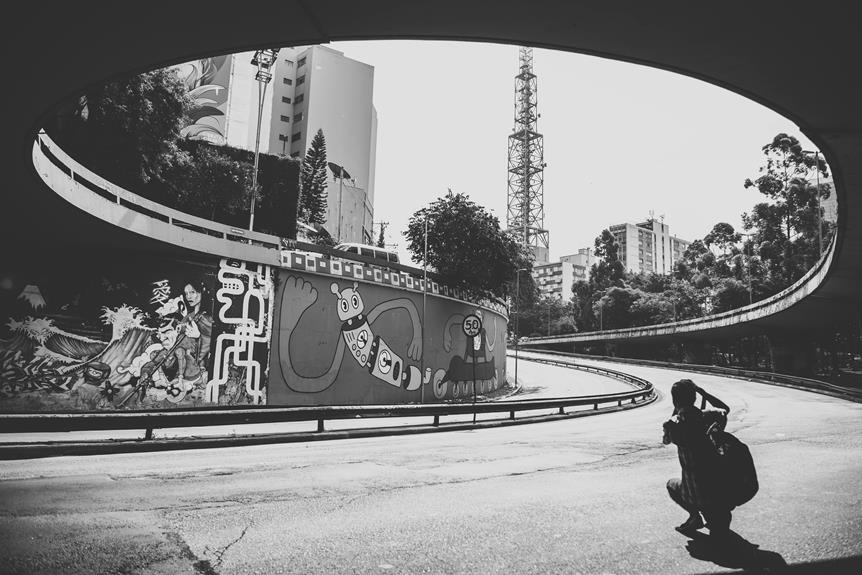Pop Art Images

Pop art images bridge mass culture with fine art, offering vivid, thought-provoking commentary on consumerism and media saturation. You’ll recognize iconic works like Andy Warhol’s ‘Campbell’s Soup Cans’ and Roy Lichtenstein’s ‘Whaam!’. Artists like Warhol and Lichtenstein used techniques such as repetition, bold colours, and commercial aesthetics to critique society. They employed silk screening, offset lithography, and collage, reflecting everyday life and media. This movement’s influence persists in modern fashion, design, and advertising, capturing your attention with its striking visual language. There’s much more to explore about how pop art reshaped artistic expression and cultural identity.
Key Points
- Pop art images often feature bold colours and high-contrast visuals.
- Common themes include consumerism, media, and celebrity culture.
- Techniques like silk screening and collage are prevalent in pop art.
- Iconic pieces include Warhol’s ‘Campbell’s Soup Cans’ and Lichtenstein’s ‘Whaam!’.
- Pop art images frequently draw from advertising, comic books, and everyday objects.
Origins of Pop Art
Pop art’s origins trace back to the 1950s, when artists began blending elements of mass culture with fine art to challenge traditional aesthetic boundaries.
The pop art movement drew heavily from cultural influences like advertising, television, and celebrity culture, reflecting the rapidly shifting societal norms.
As you explore its evolution, you’ll notice how artistic experimentation played a vital role. This movement introduced techniques such as repetition and the use of bold colours, which were seen as trivial by traditional standards.
These artistic choices created a new visual language.
Pop art’s evolution wasn’t just about aesthetics; it was a commentary on consumerism and the role of media in everyday life, reshaping the art world’s landscape permanently.
Key Pop Art Artists
As you explore the significant contributors to the pop art movement, you’ll encounter influential artists like Andy Warhol, Roy Lichtenstein, Claes Oldenburg, James Rosenquist, and Tom Wesselmann, each bringing a unique perspective and style that collectively defined the era.
Warhol’s work, with its emphasis on mass production, demonstrates pop art’s influence on contemporary culture. Lichtenstein’s comic book aesthetics highlight the movement’s embrace of popular media. Oldenburg’s playful sculptures challenge traditional art forms, while Rosenquist’s surreal, commercial imagery critiques consumerism. Wesselmann’s provocative pieces explore desire and consumption.
Pop art exhibitions and retrospectives frequently feature these artists, underscoring their lasting impact and relevance in modern art discussions. Their contributions continue to shape the dialogue around art today.
Iconic Pop Art Pieces
Delving into the world of iconic pop art pieces, you’ll find Andy Warhol’s ‘Campbell’s Soup Cans’ offering a poignant commentary on consumer culture through its repetitive imagery. Warhol’s work epitomizes pop art influence and underscores the cultural impact of mass production.
Consider these notable works:
- Roy Lichtenstein’s ‘Whaam!’: A dramatic airplane explosion rendered in comic book style, highlighting the intersection of high art and popular culture.
- Jasper Johns’ ‘Three Flags’: This piece layers three American flags, symbolizing both patriotism and artistic deconstruction.
- Roy Lichtenstein’s ‘Drowning Girl’: A distressed woman’s narrative in comic book form, emphasizing emotional depth.
- Andy Warhol’s ‘Marilyn Diptych’: Multiple vibrant images of Marilyn Monroe, reflecting both celebrity culture and media saturation.
These pieces collectively illustrate the profound influence of pop art on contemporary culture.
Techniques and Materials
How did pop art artists revolutionize the art scene by employing unconventional techniques and materials to capture the vibrancy of popular culture?
You’ll find that they embraced commercial printing methods like silk screening and offset lithography to create bold, repetitive visuals. Industrial materials, such as stencils and spray paint, often replaced traditional tools, adding a contemporary edge to their works.
By using collage techniques, they incorporated everyday objects and mass-produced images, making art more relatable. Vibrant colours and high-contrast imagery became hallmarks, ensuring their pieces stood out.
The combination of these innovative approaches allowed pop art to reflect the dynamic and accessible nature of popular culture, bridging the gap between high art and everyday life.
Pop Art in Modern Culture
Pop art’s vibrant visual language continues to permeate modern culture, profoundly shaping fashion, design, and advertising aesthetics. You’ll notice how contemporary artists and brands draw inspiration from its bold colors and iconic imagery, maintaining its relevance today.
Pop art in fashion manifests through striking patterns and graphic prints, while pop art in advertising leverages its eye-catching appeal to captivate audiences. This influence is evident in:
- Graphic Design: Bright, contrasting colours and playful elements.
- Street Art: Murals and installations echoing pop art’s themes.
- Digital Media: Social media visuals and web design incorporating pop art motifs.
- Marketing Campaigns: Brands adopting pop art styles to target younger demographics.
These examples underscore pop art’s enduring impact on our visual culture.
Collecting Pop Art
As pop art continues to shape modern culture, collecting these vibrant and bold images offers a unique opportunity to own a piece of this influential movement. The investment potential of pop art can’t be overstated, but you need to follow key buying tips: prioritize authenticity, provenance, and condition. Seek works by iconic artists like Warhol and Lichtenstein, whose pieces critique consumerism and mass media.
Proper preservation techniques are essential to maintaining your collection’s value. Use archival materials and control environmental factors to prevent deterioration.
For display ideas, consider rotating pieces to reduce light exposure and using UV-protective glass. By carefully curating and preserving your collection, you’ll ensure it remains a dynamic reflection of pop art’s enduring impact.
Frequently Asked Questions
What Is Pop Art Images?
You’re exploring artworks inspired by popular culture and everyday objects. Andy Warhol and Roy Lichtenstein’s pieces, with their bold colours and repetition, challenge traditional art by incorporating mass media and consumerism, reflecting societal changes.
What Makes an Image Pop Art?
An image becomes pop art when it uses bold colour palettes and cultural icons, often incorporating repetitive elements and comic book styles. You’ll notice a satirical tone, blurring the lines between high and low art.
What Is the Famous Piece of Pop Art?
The famous piece of pop art is Andy Warhol’s ‘Campbell’s Soup Cans.’ This artwork, along with Roy Lichtenstein’s comic strip paintings, exemplifies the movement’s focus on consumer culture and challenges to traditional art norms.
How Do I Make My Photos Pop Art?
To make your photos pop art, you should use digital manipulation to enhance colour saturation. Experiment with bold colours, iconic symbols, and techniques like image repetition. Photo editing software will help achieve an engaging, retro aesthetic.
Conclusion
You’ve explored the vibrant world of Pop Art, delving into its origins and iconic artists. You’ve seen how their innovative techniques and materials transformed everyday objects into high art.
Today, Pop Art’s influence permeates modern culture, resonating in fashion, advertising, and design. As you consider collecting Pop Art, remember its historical context and cultural significance.
Engaging with these pieces means appreciating their role in challenging traditional boundaries and celebrating the mundane.
Author: Jessica Hartley

